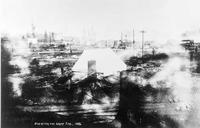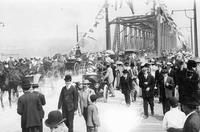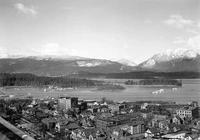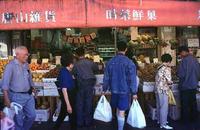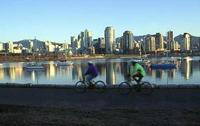Vancouver
VANCOUVER, city, pop 662,248 (2021), is the largest city in BC; Greater Vancouver, which includes the surrounding communities (pop 2,606,000), is the third largest urban area in Canada (see GREATER VANCOUVER REGIONAL DISTRICT). Located on a peninsula in the southwest corner of the province, Vancouver occupies 113 sq km of land bounded by BURRARD INLET to the north, GEORGIA STRAIT to the west and the FRASER R to the south. The snow-capped COAST MTS north of the city contribute to a dramatically beautiful setting.
Early History
Long before English and SPANISH EXPLORERS arrived in 1792, FIRST NATIONS people had settled in the area. The village of MUSQUEAM on the north arm of the Fraser R in what is now southwest Vancouver was a large centre from which the Musqueam people moved to surrounding waters to fish. In Burrard Inlet and FALSE CRK they encountered other Coast Salish peoples similarly engaged (see SALISHAN FIRST NATIONS). Europeans fundamentally disrupted this way of life when drawn to the area by the GOLD RUSH of the late 1850s and 1860s. Lumber mills established on either side of Burrard Inlet in the 1860s marked the onset of industrialism (see GRANVILLE), and the pace of change was accelerated further by the decision of the CPR to make the inlet the western terminus of its transcontinental railway. The provincial government encouraged this decision by transferring to the CPR more than 25 sq km of land at the site. On 6 Apr 1886 the legislature incorporated the City of Vancouver, a name chosen by William van Horne, a CPR executive, to give the city a recognizable identity by honouring the British naval explorer George VANCOUVER. Two months later, on 13 June, the fledgling community was dealt a terrible blow when a clearing fire burned out of control and in less than an hour destroyed most of the city (see DISASTERS). However, rebuilding began immediately.
Vancouver experienced a recurring cycle of boom followed by recession in the pre-WWI period, including rapid growth spurts from 1897 to 1906 and 1908 to 1912. Renewed growth in the 1920s culminated with the incorporation into Vancouver of South Vancouver and Point Grey in 1929. It was at this time that the city passed Winnipeg as the largest city in western Canada. However, this growth spurt was followed by more hard times in the 1930s. Only since the onset of WWII and the prosperity that followed has the city experienced a long period of relatively sustained economic expansion. The early pattern of boom and bust reflected Vancouver's ties to the provincial economy of MINING, commercial FISHING and the FOREST INDUSTRY, over which it had emerged by the early 1900s as the regional centre. Located on an excellent harbour, it was also an important transportation centre featuring coastal shipping, trans-Pacific steamers and, by 1915, 2 transcontinental railways. But the city enjoyed much less success as a manufacturing centre, and as recently as the 1960s large SAWMILLS along its Fraser R and False Crk shorelines testified to the city's continuing links to the surrounding resource economy.
Rise of the Modern City
In the 1960s Vancouver began to shed its image as "a village at the edge of the rain forest" and to develop the attributes of a big city. As high-rise apartment buildings replaced aging family homes, the West End, once home to the city's elite, evolved into Canada's most densely populated urban neighbourhood. Dozens of new office towers transformed the downtown, while the sawmills and machine shops of False Crk began closing, replaced in the 1970s by condominiums. In a city where as late as 1971 one half of the metropolitan-area population still lived in the urban core, 3 new bridges over waterways around Vancouver and a tunnel under the south arm of the Fraser R accelerated suburbanization, creating a band of single-family communities around an increasingly dense centre where singles and families with children chose to reside. These people are able to continue to live in the inner city because in 1967 community activists and urban reformers successfully prevented it from being destroyed by freeways.
From the 1960s to the 1990s Vancouver also emerged as an international city tied less to the local resource economy and more to other PACIFIC RIM countries through trade, TOURISM and finance. The extraordinary success of EXPO 86 accelerated this transformation and increased the flow of Asian capital into Greater Vancouver. The city's Asian population grew dramatically in the late 1980s and 1990s, creating in the suburb of RICHMOND a new Chinese commercial centre that rivalled Vancouver's historic CHINATOWN as a community hub. By the turn of the century immigrants from Hong Kong and India constituted the 2 largest Asian groups among a great mix of peoples who have given the city its distinctive cosmopolitan character. Vancouver at the beginning of the 21st century contrasts sharply with the overwhelmingly British and Anglo-Canadian city of the past: as recently as 1971 more than 60% of the residents of Greater Vancouver still identified with family ancestry in Britain. The city has also begun to put behind it a long history of racial antipathy by its European majority toward aboriginal and non-white minorities, particularly people of Asian heritage. This hostility was highlighted by the 1907 riots in Chinatown and Japantown (see ASIATIC EXCLUSION LEAGUE), the KOMAGATA MARU incident in 1914, and the expulsion of JAPANESE residents from the coast in 1942 (see JAPANESE, RELOCATION OF). Newcomers from other parts of Asia, as well as Africa, the Middle East, Eastern Europe, South and Central America and other parts of Canada have also contributed their languages, their foods and their arts to Vancouver's distinctive cultural mix.
City Sights
Despite its fast growth during the latter third of the 20th century, Vancouver is generally regarded as a slow-paced, "laid-back" city whose residents take time to enjoy recreation and entertainment. Tourism has always been an economic mainstay, thanks to the mild climate and magnificent setting, with excellent hiking, ROCK CLIMBING, SKIING, SNOWBOARDING, boating, horseback riding, swimming, beachcombing and birdwatching available nearby. Public gardens and huge parks adjoin areas of dense urban population (see QUEEN ELIZABETH PARK; STANLEY PARK), and Vancouverites support many outdoor events such as the VANCOUVER FOLK MUSIC FESTIVAL, DRAGON BOAT races, Bard on the Beach Shakespeare Festival, Vancouver Children's Festival, Symphony of Fire, celebrations of the Chinese New Year, and an annual lantern festival organized by the Public Dreams Society. The city's cultural life also includes live music, DANCE, literary, THEATRE and sports events; a new public library complex, completed in 1995; the CBC building; the VANCOUVER AQUARIUM; 2 universities—UBC and SFU—as well as the EMILY CARR UNIVERSITY OF ART & DESIGN and a number of COMMUNITY COLLEGE campuses; a vital city archives founded by Major J.S. MATTHEWS, located in a large waterfront park which also contains the H.R. MacMILLAN SPACE CENTRE and the VANCOUVER MARITIME MUSEUM.
Not everyone shares in the affluent "latte lifestyle" promoted by the city's boosters. The Downtown Eastside neighbourhood, adjacent to the historic districts of GASTOWN and Chinatown, has gained a reputation as the poorest postal code in Canada. Drug use, crime, prostitution, homelessness and other problems of the modern city are most intense in this small area of 16,000 residents, but they are a fact of life in almost every district of Vancouver. The city also faces serious problems associated with rapid growth, among them increasing traffic congestion and deteriorating air and water quality. These challenges give immediacy to a debate of some years' standing about the future. The noted Vancouver architect Arthur ERICKSON urged Vancouverites to prepare for dramatic growth, predicting that by the year 2040, Vancouver will be a megacity of 10–25 million people. Others want to curtail expansion and recover the small-city character of the past, marked by low-density housing, peaceful neighbourhoods, quiet streets and courteous drivers. Given the pro-development bias of local government throughout most of Vancouver's history, encouraged by the provincial government's development activities during the years leading up to Expo 86, and given the increasingly integrated nature of economies in Asia and N America, Vancouver's transformation from "urban village" to "world city" is likely to continue. See maps of Vancouver and charts showing Vancouver's demographics.
by Robert A.J. McDonald
Reading: Patricia Roy, Vancouver: An Illustrated History, 1980; Graeme Wynn and Timothy Oke, eds, Vancouver and Its Regions, 1992; Bruce Macdonald, Vancouver: A Visual History, 1992; Robert A.J. McDonald, Making Vancouver: Class, Status and Social Boundaries, 1996; Chuck Davis, ed, The Greater Vancouver Book, 1997; Daniel Francis, Becoming Vancouver, 2021.

